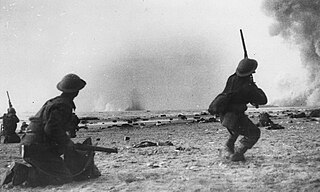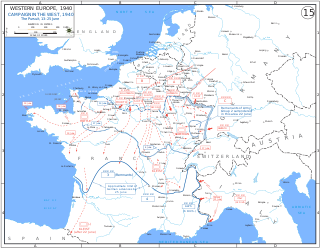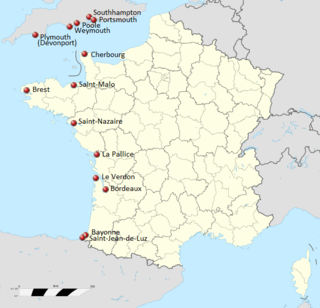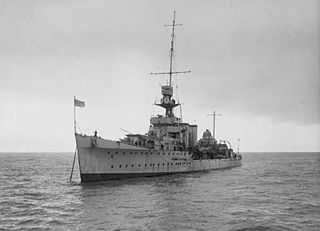Related Research Articles

The Battle of Dunkirk was fought around the French port of Dunkirk (Dunkerque) during the Second World War, between the Allies and Nazi Germany. As the Allies were losing the Battle of France on the Western Front, the Battle of Dunkirk was the defence and evacuation of British and other Allied forces to Britain from 26 May to 4 June 1940.

Fall Rot was the plan for a German military operation after the success of Fall Gelb, the Battle of France, an invasion of the Benelux countries and northern France. The Allied armies had been defeated and pushed back in the north to the Channel coast, which culminated in the Dunkirk evacuation. The operation to complete the conquest of France by the German Army began on 5 June 1940. Fall Rot began with a preliminary attack over the river Somme on the Channel Coast to the Seine, beginning on 5 June and the main offensive by Army Group A on 9 June further east over the river Aisne.

The Dunkirk evacuation, codenamed Operation Dynamo and also known as the Miracle of Dunkirk, or just Dunkirk, was the evacuation of Allied soldiers during World War II from the beaches and harbour of Dunkirk, in the north of France, between 26 May and 4 June 1940. The operation commenced after large numbers of Belgian, British, and French troops were cut off and surrounded by German troops during the six-week Battle of France. In a speech to the House of Commons, British Prime Minister Winston Churchill called this "a colossal military disaster", saying "the whole root and core and brain of the British Army" had been stranded at Dunkirk and seemed about to perish or be captured. In his "We shall fight on the beaches" speech on 4 June, he hailed their rescue as a "miracle of deliverance".

Operation Aerial was the evacuation of Allied forces and civilians from ports in western France from 15 to 25 June 1940 during the Second World War. The evacuation followed the Allied military collapse in the Battle of France against Nazi Germany. Operation Dynamo, the evacuation from Dunkirk and Operation Cycle, an embarkation from Le Havre, finished on 13 June. British and Allied ships were covered from French bases by five Royal Air Force (RAF) fighter squadrons and assisted by aircraft based in England, to lift British, Polish and Czech troops, civilians and equipment from Atlantic ports, particularly from St Nazaire and Nantes.

Saint-Nazaire is a commune in the Loire-Atlantique department in western France, in traditional Brittany.

RMS Lancastria was a British ocean liner requisitioned by the UK Government during the Second World War. She was sunk on 17 June 1940 during Operation Aerial. Having received an emergency order to evacuate British nationals and troops from France the ship was loaded well in excess of its capacity of 1,300 passengers. Modern estimates suggest that between 3,000 and 5,800 people died during the sinking — the largest single-ship loss of life in British maritime history.

RMS Scythia was a Cunard ocean liner. She sailed on her maiden voyage in 1921, and became a troop and supply ship during the Second World War. Scythia was the longest serving Cunard liner until 4 September 2005, when her record was surpassed by RMS Queen Elizabeth 2.

Saint-Jean-de-Luz is a commune in the Pyrénées-Atlantiques department, southwestern France. Saint-Jean-de-Luz is part of the Basque province of Labourd (Lapurdi).
The Timeline of the Battle of France, also known as the Fall of France, covers the period during World War II from the first military actions between Germany and France and to the armistice signed by France. Over the period of six weeks, from May 10 to June 25, 1940, Nazi Germany had also conquered Belgium, Netherlands and Luxembourg. Nazi Germany's overall plan was to invade the Low Countries which would make the French and British troops leave their current position and position their forces in Belgium. Then, a second force would navigate through the Ardennes Forest and move around the Maginot Line at the weakest part of the Allied defences. The force would then move towards the west French coast and cut the northern Allied force off. The Germans would then capture Paris, eliminate any resistance that remained, cross the English Channel, and invade the United Kingdom.

SS Arandora Star, originally SS Arandora, was a British passenger ship of the Blue Star Line. She was built in 1927 as an ocean liner and refrigerated cargo ship, converted in 1929 into a cruise ship and requisitioned as a troopship in the Second World War. At the end of June 1940 she was assigned the task of transporting Italian and German civilians among a small number of prisoners of war to Canada. On 2 July 1940 she was sunk by a German U-boat off the coast of Ireland with a large loss of life, 805 people.
Events from the year 1940 in the United Kingdom. The year was dominated by Britain's involvement in the Second World War, which commenced in September the previous year, as well as the numerous enemy air raids on Britain and thousands of subsequent casualties. Although the war continued, Britain did triumph in the Battle of Britain and foiled Nazi Germany's invasion attempt.
The following events occurred in June 1940:

MS Batory was a Polish ocean liner which was the flagship of Gdynia-America Line, named after Stefan Batory, the sixteenth-century king of Poland. She was the sister ship of MS Piłsudski. After Allied wartime service, mainly under the UK Admiralty, she became in 1951 the flagship of the Polish Ocean Lines and the Polish merchant fleet. She is often described as the "Pride of the Polish Merchant Marine". Batory along with her sister Piłsudski were the two most popular ocean liners of Poland.

The military history of Gibraltar during World War II exemplifies Gibraltar's position as a British fortress since the early 18th century and as a vital factor in British military strategy, both as a foothold on the continent of Europe, and as a bastion of British sea power. During World War II, Gibraltar served a vital role in both the Atlantic Theatre and the Mediterranean Theatre, controlling virtually all naval traffic into and out of the Mediterranean Sea from the Atlantic Ocean.

HMS Calcutta was a C-class light cruiser of the Royal Navy, named after the Indian city of Calcutta. She was part of the Carlisle group of the C-class of cruisers. She was laid down by Vickers Limited at Barrow-in-Furness in 1917 and launched on 9 July 1918. Calcutta was commissioned too late to see action in the First World War and was converted to an anti-aircraft cruiser in 1939. Calcutta served during the Norwegian Campaign and the evacuation from Dunkirk in 1940. She was used to escort allied convoys across the Mediterranean and was sunk on 1 June 1941 by Luftwaffe aircraft off Alexandria, Egypt.

HMS Harvester was an H-class destroyer originally ordered by the Brazilian Navy with the name Jurua in the late 1930s, but bought by the Royal Navy after the beginning of World War II in September 1939. Almost immediately after being commissioned, in May 1940, the ship began evacuating Allied troops from Dunkirk and other locations in France. Afterwards she was assigned to the Western Approaches Command for convoy escort duties. Harvester and another destroyer sank a German submarine in October. She was briefly assigned to Force H in May 1941, but her anti-aircraft armament was deemed too weak and she was transferred to the Newfoundland Escort Force in June 1941 for escort duties in the North Atlantic. The ship was returned to the Western Approaches Command in October 1941 and was converted to an escort destroyer in early 1942. Harvester was torpedoed and sunk in March 1943 by a German submarine after having rammed and sunk another submarine the previous day while escorting Convoy HX 228.
Events from the year 1940 in France.

HMS Comet was a C-class destroyer built for the Royal Navy in the early 1930s. She saw service in the Home and Mediterranean Fleets and the ship spent six months during the Spanish Civil War in late 1936 in Spanish waters, enforcing the arms blockade imposed by Britain and France on both sides of the conflict. Comet transferred to the Royal Canadian Navy (RCN) in 1938 and renamed HMCS Restigouche. During World War II, she served as a convoy escort in the battle of the Atlantic, on anti-submarine patrols during the invasion of Normandy, and was employed as a troop transport after VE Day for returning Canadian servicemen, before being decommissioned in late 1945. Restigouche was sold for scrap in 1946.

The second HMS Vega was a V-class destroyer of the British Royal Navy that saw service in World War I and World War II.
The evacuation of civilians from the Channel Islands in 1940 was an organised, partial, nautical evacuation of Crown dependencies in the Channel Islands, primarily from Jersey, Guernsey, and Alderney to Great Britain during World War II. The evacuation occurred in phases, starting with school aged children, their teachers, and mother volunteers. The islands and the British military began the evacuation following the Allies' loss in the Battle of France, after which the British Army withdrew from the islands.
References
- 1 2 3 "Taffrail" (Henry Taprell Dorling) (1973). Blue Star Line at War, 1939–45. London: W. Foulsham & Co. p. 43. ISBN 0-572-00849-X.
- 1 2 3 4 5 "OPERATION AERIAL".